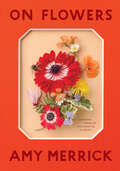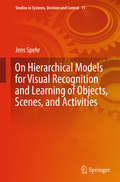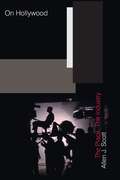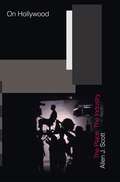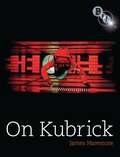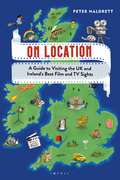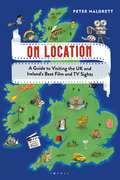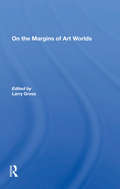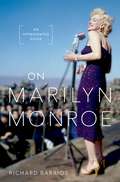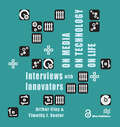- Table View
- List View
On Film Editing: An Introduction to the Art of Film Construction (Edward Dmytryk: On Filmmaking)
by Edward DmytrykIn On Film Editing, director Edward Dmytryk explains, in clear and engaging terms, the principles of film editing. Using examples and anecdotes from almost five decades in the film industry, Dmytryk offers a masterclass in film and video editing. Written in an informal, "how-to-do-it" style, Dmytryk shares his expertise and experience in film editing in a precise and philosophical way, contending that all parties on the film crew—from the camera assistant to the producer and director—must understand film editing to produce a truly polished work. Originally published in 1984, this reissue of Dmytryk’s classic editing book includes a new critical introduction by Andrew Lund, as well as chapter lessons, discussion questions, and exercises.
On Film Editing: An Introduction to the Art of Film Construction (Edward Dmytryk: On Filmmaking)
by Edward DmytrykIn On Film Editing, director Edward Dmytryk explains, in clear and engaging terms, the principles of film editing. Using examples and anecdotes from almost five decades in the film industry, Dmytryk offers a masterclass in film and video editing. Written in an informal, "how-to-do-it" style, Dmytryk shares his expertise and experience in film editing in a precise and philosophical way, contending that all parties on the film crew—from the camera assistant to the producer and director—must understand film editing to produce a truly polished work. Originally published in 1984, this reissue of Dmytryk’s classic editing book includes a new critical introduction by Andrew Lund, as well as chapter lessons, discussion questions, and exercises.
On Flowers: Lessons from an Accidental Florist
by Amy MerrickA one-of-a-kind journey into the mind of beloved floral designer Amy Merrick, celebrating the beauty and possibilities of nature and how to use it to create elegant, ephemeral arrangements.
On Frank Lloyd Wright's Concrete Adobe: Irving Gill, Rudolph Schindler and the American Southwest (Ashgate Studies in Architecture)
by Donald Leslie JohnsonDuring the years 1919 into 1925 Frank Lloyd Wright worked on four houses and a kindergarten located in metropolitan Los Angeles using concrete blocks as the main building material. The construction system has been described by Wright and others as ’uniquely molded’, ’woven like a textile fabric’ and perceived as ground breaking, truly modern, unprecedented. Many have attempted to uphold these claims while some thought the house-designs borrowed from old exotic buildings. For the first time this book brings together Wright’s declarations, the support of upholders and inferences in order to determine their accuracy and correctness, or the possibility of feigned or fictional stories. It examines technical developments of concrete blocks by Wright and others before his experiences in Los Angeles began in 1919. It also studies the manner of Wright’s design process by an examination of relevant pictorial and textual documents. A unique, in-depth and critical analysis of the houses is set within historical, biographical and theoretical contexts. Consequently, the book explains the impact upon Wright of California contemporaries, architects Irving Gill and Rudolph Schindler, and their instrumentally profound role upon the course of modernism 1907-1923. In doing so, it allows a full appreciation of Wright’s, Gill’s and Schindler’s buildings beyond their experiential qualities.
On Frank Lloyd Wright's Concrete Adobe: Irving Gill, Rudolph Schindler and the American Southwest (Ashgate Studies in Architecture)
by Donald Leslie JohnsonDuring the years 1919 into 1925 Frank Lloyd Wright worked on four houses and a kindergarten located in metropolitan Los Angeles using concrete blocks as the main building material. The construction system has been described by Wright and others as ’uniquely molded’, ’woven like a textile fabric’ and perceived as ground breaking, truly modern, unprecedented. Many have attempted to uphold these claims while some thought the house-designs borrowed from old exotic buildings. For the first time this book brings together Wright’s declarations, the support of upholders and inferences in order to determine their accuracy and correctness, or the possibility of feigned or fictional stories. It examines technical developments of concrete blocks by Wright and others before his experiences in Los Angeles began in 1919. It also studies the manner of Wright’s design process by an examination of relevant pictorial and textual documents. A unique, in-depth and critical analysis of the houses is set within historical, biographical and theoretical contexts. Consequently, the book explains the impact upon Wright of California contemporaries, architects Irving Gill and Rudolph Schindler, and their instrumentally profound role upon the course of modernism 1907-1923. In doing so, it allows a full appreciation of Wright’s, Gill’s and Schindler’s buildings beyond their experiential qualities.
On Freedom: Four Songs of Care and Constraint
by Maggie Nelson*A GUARDIAN 'BOOKS OF 2021' PICK*'One of the most electrifying writers at work in America today, among the sharpest and most supple thinkers of her generation' - Olivia LaingSo often deployed as a jingoistic, even menacing rallying cry, or limited by a focus on passing moments of liberation, the rhetoric of freedom both rouses and repels. Does it remain key to our autonomy, justice, and well-being, or is freedom's long star turn coming to a close? Does a continued obsession with the term enliven and emancipate, or reflect a deepening nihilism (or both)? On Freedom examines such questions by tracing the concept's complexities in four distinct realms: art, sex, drugs, and climate. Drawing on a vast range of material, from critical theory to pop culture to the intimacies and plain exchanges of daily life, Nelson explores how we might think, experience, or talk about freedom in ways responsive to the conditions of our day. Her abiding interest lies in ongoing "practices of freedom" by which we negotiate our interrelation with-indeed, our inseparability from-others, with all the care and constraint that relation entails, while accepting difference and conflict as integral to our communion. For Nelson, thinking publicly through the knots in our culture-from recent art world debates to the turbulent legacies of sexual liberation, from the painful paradoxes of addiction to the lure of despair in the face of the climate crisis-is itself a practice of freedom, a means of forging fortitude, courage, and company. On Freedom is an invigorating, essential book for challenging times.
On Hierarchical Models for Visual Recognition and Learning of Objects, Scenes, and Activities (Studies in Systems, Decision and Control #11)
by Jens SpehrIn many computer vision applications, objects have to be learned and recognized in images or image sequences. This book presents new probabilistic hierarchical models that allow an efficient representation of multiple objects of different categories, scales, rotations, and views. The idea is to exploit similarities between objects and object parts in order to share calculations and avoid redundant information. Furthermore inference approaches for fast and robust detection are presented. These new approaches combine the idea of compositional and similarity hierarchies and overcome limitations of previous methods. Besides classical object recognition the book shows the use for detection of human poses in a project for gait analysis. The use of activity detection is presented for the design of environments for ageing, to identify activities and behavior patterns in smart homes. In a presented project for parking spot detection using an intelligent vehicle, the proposed approaches are used to hierarchically model the environment of the vehicle for an efficient and robust interpretation of the scene in real-time.
On Hollywood: The Place, The Industry
by Allen J. ScottWhy is the U.S. motion picture industry concentrated in Hollywood and why does it remain there in the age of globalization? Allen Scott uses the tools of economic geography to explore these questions and to provide a number of highly original answers. The conceptual roots of his analysis go back to Alfred Marshall's theory of industrial districts and pick up on modern ideas about business clusters as sites of efficient and innovative production. On Hollywood builds on this work by adding major new empirical elements. By examining the history of motion-picture production from the early twentieth century to the present through this analytic lens, Scott is able to show why the industry (which was initially focused on New York) had shifted the majority of its production to Southern California by 1919. He also addresses in detail the bases of Hollywood's long-standing creative energies and competitive advantages. At the same time, the book explores the steady globalization of Hollywood's market reach as well as the cultural and political dilemmas posed by this phenomenon. On Hollywood will appeal not only to general readers with an interest in the motion-picture industry, but also to economic geographers, business professionals, regional development practitioners, and cultural theorists as well.
On Hollywood: The Place, The Industry (PDF)
by Allen J. ScottWhy is the U.S. motion picture industry concentrated in Hollywood and why does it remain there in the age of globalization? Allen Scott uses the tools of economic geography to explore these questions and to provide a number of highly original answers. The conceptual roots of his analysis go back to Alfred Marshall's theory of industrial districts and pick up on modern ideas about business clusters as sites of efficient and innovative production. On Hollywood builds on this work by adding major new empirical elements. By examining the history of motion-picture production from the early twentieth century to the present through this analytic lens, Scott is able to show why the industry (which was initially focused on New York) had shifted the majority of its production to Southern California by 1919. He also addresses in detail the bases of Hollywood's long-standing creative energies and competitive advantages. At the same time, the book explores the steady globalization of Hollywood's market reach as well as the cultural and political dilemmas posed by this phenomenon. On Hollywood will appeal not only to general readers with an interest in the motion-picture industry, but also to economic geographers, business professionals, regional development practitioners, and cultural theorists as well.
On Illustration (Oberon Masters Series)
by Andrzej KlimowskiDrawing is perhaps the most immediate medium through which an idea can be articulated. Illustration takes drawing into the narrative realm. The illustrations that we see as children stay with us forever; they play a seminal role in the development of our imagination. On Illustration argues that this unassuming artistic discipline can enrich a person’s experience of cultural life provided the illustrator’s talent is matched by the courage and intelligence of the client. The book is an insight into Andrzej Klimowski’s practice, and will help define the role and status of the illustrator in today’s creative industries.‘Recommended reading’ - Association of Illustrators
On Kubrick
by James NaremoreOn Kubrick provides an illuminating critical account of the films of Stanley Kubrick, from his earliest feature, Fear and Desire (1953), to the posthumously-produced A.I. Artificial Intelligence (Steven Spielberg, 2001). The book offers provocative analysis of each of Kubrick's films, together with new information about their production histories and cultural contexts. Its ultimate aim is to provide a concise yet thorough discussion that will be useful as both an academic text and a trade publication. James Naremore argues that in several respects Kubrick was one of the cinema's last modernists: his taste and sensibility were shaped by the artistic culture of New York in the 1950s; he became a celebrated auteur who forged a distinctive style; he used art-cinema conventions in commercial productions; he challenged censorship regulations; and throughout his career he was preoccupied with one of the central themes of modernist art – the conflict between rationality and its ever-present shadow, the unconscious. War and science are key concerns in Kubrick's oeuvre, and his work has a hyper-masculine quality. Yet no director has more relentlessly emphasized the absurdity of combat, as in Paths of Glory (1957) and Full Metal Jacket (1987), the failure of scientific reasoning, as in 2001 (1968), and the fascistic impulses in masculine sexuality, as in Dr Strangelove (1964) and Eyes Wide Shut (1999). The book also argues that while Kubrick was a voracious intellectual and a life-long autodidact, the fascination of his work has less to do with the ideas it espouses than with the emotions it evokes. Often described as 'cool' or 'cold,' Kubrick is best understood as a skillful practitioner of what might be called the aesthetics of the grotesque; he employs extreme forms of caricature and black comedy to create disgusting, frightening yet also laughable images of the human body, creating a sense of unease that leaves viewers unsure of how to react.
On Kubrick
by James NaremoreOn Kubrick provides an illuminating critical account of the films of Stanley Kubrick, from his earliest feature, Fear and Desire (1953), to the posthumously-produced A.I. Artificial Intelligence (Steven Spielberg, 2001). The book offers provocative analysis of each of Kubrick's films, together with new information about their production histories and cultural contexts. Its ultimate aim is to provide a concise yet thorough discussion that will be useful as both an academic text and a trade publication. James Naremore argues that in several respects Kubrick was one of the cinema's last modernists: his taste and sensibility were shaped by the artistic culture of New York in the 1950s; he became a celebrated auteur who forged a distinctive style; he used art-cinema conventions in commercial productions; he challenged censorship regulations; and throughout his career he was preoccupied with one of the central themes of modernist art – the conflict between rationality and its ever-present shadow, the unconscious. War and science are key concerns in Kubrick's oeuvre, and his work has a hyper-masculine quality. Yet no director has more relentlessly emphasized the absurdity of combat, as in Paths of Glory (1957) and Full Metal Jacket (1987), the failure of scientific reasoning, as in 2001 (1968), and the fascistic impulses in masculine sexuality, as in Dr Strangelove (1964) and Eyes Wide Shut (1999). The book also argues that while Kubrick was a voracious intellectual and a life-long autodidact, the fascination of his work has less to do with the ideas it espouses than with the emotions it evokes. Often described as 'cool' or 'cold,' Kubrick is best understood as a skillful practitioner of what might be called the aesthetics of the grotesque; he employs extreme forms of caricature and black comedy to create disgusting, frightening yet also laughable images of the human body, creating a sense of unease that leaves viewers unsure of how to react.
On Kubrick: Revised Edition
by James NaremoreIn a comprehensively revised and updated new edition, James Naremore provides an illuminating critical account of the films of Stanley Kubrick, from his earliest feature, Fear and Desire (1953), to the posthumously-produced A.I. Artificial Intelligence (Steven Spielberg, 2001). Naremore offers provocative analyses of each of Kubrick's films, considering his emphasis on the absurdity of combat, as in Paths of Glory (1957) and Full Metal Jacket (1987), the failure of scientific reasoning, as in 2001 (1968), and the fascistic impulses in masculine sexuality, as in Dr Strangelove (1964) and Eyes Wide Shut (1999). He argues that while Kubrick was a voracious intellectual and a life-long autodidact, the fascination of his work has less to do with the ideas it espouses than with the emotions it evokes. Combining close readings with new insights into the production histories and cultural contexts of key films, Naremore provides a concise yet thorough discussion that will be useful to students of Kubrick's filmmaking and cinephiles who seek a deeper insight into the work of this perfectionist genius.Revised throughout, this new edition also includes a fully updated bibliography of critical writings on Kubrick's cinema.
On Kubrick: Revised Edition
by James NaremoreIn a comprehensively revised and updated new edition, James Naremore provides an illuminating critical account of the films of Stanley Kubrick, from his earliest feature, Fear and Desire (1953), to the posthumously-produced A.I. Artificial Intelligence (Steven Spielberg, 2001). Naremore offers provocative analyses of each of Kubrick's films, considering his emphasis on the absurdity of combat, as in Paths of Glory (1957) and Full Metal Jacket (1987), the failure of scientific reasoning, as in 2001 (1968), and the fascistic impulses in masculine sexuality, as in Dr Strangelove (1964) and Eyes Wide Shut (1999). He argues that while Kubrick was a voracious intellectual and a life-long autodidact, the fascination of his work has less to do with the ideas it espouses than with the emotions it evokes. Combining close readings with new insights into the production histories and cultural contexts of key films, Naremore provides a concise yet thorough discussion that will be useful to students of Kubrick's filmmaking and cinephiles who seek a deeper insight into the work of this perfectionist genius.Revised throughout, this new edition also includes a fully updated bibliography of critical writings on Kubrick's cinema.
On Literature and Art
by Mao Tse-TungThis historic document brilliantly exemplifies the profound integration of Marxism-Leninism with the practice of the Chinese revolution.
On Location: A Guide to Visiting the UK and Ireland's Best Film and TV Sights
by Peter NaldrettFor popular-culture vultures, there really is no better guide to Britain's best TV and film locations than On Location. With their historical charm, scenic beauty and diverse cities, the United Kingdom and Ireland have proved to be popular backdrops for film and TV directors over the decades. Whether it be the period piece Bridgerton, the gritty drama Game of Thrones, the adrenaline-fuelled Mission: Impossible series or the sci-fi trailblazer Doctor Who, the UK and Ireland have been on hand to lend buildings, countryside and natural features to some of the most gripping on-screen moments.On Location presents some of the finest destinations around the British Isles to appear in cinema and on TV, and details exactly how you can go about visiting them. Attractions range from London's bustling city centre,home to many James Bond movies, to secluded stately homes that have hosted elaborate productions of Pride and Prejudice, and offbeat urban buildings featured in well-loved shows such as Only Fools and Horses and The Young Ones. Featuring over 100 TV shows and blockbuster films, this guidebook is sure to keep even the mostobsessive film buff occupied for years.
On Location: A Guide to Visiting the UK and Ireland's Best Film and TV Sights
by Peter NaldrettFor popular-culture vultures, there really is no better guide to Britain's best TV and film locations than On Location. With their historical charm, scenic beauty and diverse cities, the United Kingdom and Ireland have proved to be popular backdrops for film and TV directors over the decades. Whether it be the period piece Bridgerton, the gritty drama Game of Thrones, the adrenaline-fuelled Mission: Impossible series or the sci-fi trailblazer Doctor Who, the UK and Ireland have been on hand to lend buildings, countryside and natural features to some of the most gripping on-screen moments.On Location presents some of the finest destinations around the British Isles to appear in cinema and on TV, and details exactly how you can go about visiting them. Attractions range from London's bustling city centre,home to many James Bond movies, to secluded stately homes that have hosted elaborate productions of Pride and Prejudice, and offbeat urban buildings featured in well-loved shows such as Only Fools and Horses and The Young Ones. Featuring over 100 TV shows and blockbuster films, this guidebook is sure to keep even the mostobsessive film buff occupied for years.
On The Margins Of Art Worlds
by Larry GrossDuring the late 1980s, the near-worship of artistic genius produced auction sales of works by Vmcent Van Gogh and Pablo Picasso for tens of millions of dollars, over $15 million for a painting by Jasper Johns, and record prices for works by many other deceased and even living masters. At the same time, it was no longer controversial in academic and intellectual circles to maintain that art works are the products of what Howard Becker has termed collective activity carried out within loosely defined art worlds: Works of art, from this point of view, are not the products of individual makers, "artists" who possess a rare and special gift. They are, rather, joint products of all the people who cooperate via an art world's characteristic conventions to bring works like that into existence. Artists are some sub-group of the world's participants who, by common agreement, possess a specialgift, therefore make a unique and indispensable contribution to the work, and thereby make it art. (1982: 35) The concept of the art world-with its central focus on the collective, social, and conventional nature of artistic production, distribution, and appreciation--confronts and potentially undermines the romantic ideology of art and artists still dominant in Western societies.
On The Margins Of Art Worlds
by Larry GrossDuring the late 1980s, the near-worship of artistic genius produced auction sales of works by Vmcent Van Gogh and Pablo Picasso for tens of millions of dollars, over $15 million for a painting by Jasper Johns, and record prices for works by many other deceased and even living masters. At the same time, it was no longer controversial in academic and intellectual circles to maintain that art works are the products of what Howard Becker has termed collective activity carried out within loosely defined art worlds: Works of art, from this point of view, are not the products of individual makers, "artists" who possess a rare and special gift. They are, rather, joint products of all the people who cooperate via an art world's characteristic conventions to bring works like that into existence. Artists are some sub-group of the world's participants who, by common agreement, possess a specialgift, therefore make a unique and indispensable contribution to the work, and thereby make it art. (1982: 35) The concept of the art world-with its central focus on the collective, social, and conventional nature of artistic production, distribution, and appreciation--confronts and potentially undermines the romantic ideology of art and artists still dominant in Western societies.
On Marilyn Monroe: An Opinionated Guide
by Richard BarriosMarilyn Monroe has been gone for over sixty years, and yet people are still talking about her. What, exactly, is the spell she casts on so many? Stunning, exciting to watch, incredibly famous, Monroe lived a very public life and died young, with a sad suddenness. All of this is true, and yet there is so much more to her story. On Marilyn Monroe: An Opinionated Guide looks past the sensation to the real legacy--her richly varied body of work. Both during her life and following her death, Monroe was dismissed as more of a phenomenon than an actor, often an object of ridicule instead of a performer whose work could be taken seriously. Even when films such as The Seven Year Itch and Some Like It Hot saw immense success, Monroe seldom got her due as the inventive and accomplished performer she was. The truth that lay behind the dazzling surface was that she was one of the hardest working of actors. Rigorously applying both skillful technique and an inherent charisma, she was able to create truly unforgettable performances. In this lively guide, Richard Barrios looks beyond the ballyhoo and legend at Monroe's best-known films, and some that even today remain obscure. Besides her films, it also addresses the work she did on television and the stage, as well as her underrated abilities as a vocalist. Both an informative study and a perceptive critical assessment, On Marilyn Monroe: An Opinionated Guide gives this brilliant performer the attention she desired--that of an artist whose work deserves both examination and celebration.
On Marilyn Monroe: An Opinionated Guide
by Richard BarriosMarilyn Monroe has been gone for over sixty years, and yet people are still talking about her. What, exactly, is the spell she casts on so many? Stunning, exciting to watch, incredibly famous, Monroe lived a very public life and died young, with a sad suddenness. All of this is true, and yet there is so much more to her story. On Marilyn Monroe: An Opinionated Guide looks past the sensation to the real legacy--her richly varied body of work. Both during her life and following her death, Monroe was dismissed as more of a phenomenon than an actor, often an object of ridicule instead of a performer whose work could be taken seriously. Even when films such as The Seven Year Itch and Some Like It Hot saw immense success, Monroe seldom got her due as the inventive and accomplished performer she was. The truth that lay behind the dazzling surface was that she was one of the hardest working of actors. Rigorously applying both skillful technique and an inherent charisma, she was able to create truly unforgettable performances. In this lively guide, Richard Barrios looks beyond the ballyhoo and legend at Monroe's best-known films, and some that even today remain obscure. Besides her films, it also addresses the work she did on television and the stage, as well as her underrated abilities as a vocalist. Both an informative study and a perceptive critical assessment, On Marilyn Monroe: An Opinionated Guide gives this brilliant performer the attention she desired--that of an artist whose work deserves both examination and celebration.
On Media, On Technology, On Life - Interviews with Innovators
by Arthur Clay, Timothy J. SeniorThe book 'On Media, On Technology, On Life: Interviews with Innovators' features thirteen artist-researchers whose artworks reconfigure the relationships between living bodies, microorganisms, tools, techniques, and institutions to ask new questions of life itself. When encountered for the first time, these are works that seem to challenge a conventional understanding of what artists and scientists do. Through the words of the artists themselves, these interviews explore what it means to spearhead innovative new partnerships able to create work that takes on a life of its own. By posing new questions at the interface between media, technology, and life, the book explores themes such as the life of multi-species bodies, the future of food security in the age of biotechnology, the microbial lives of historic archives, and the biohacker communities of the future. Together, they reveal how we are all actors in this theatre of life innovation.
On Media, On Technology, On Life - Interviews with Innovators
The book 'On Media, On Technology, On Life: Interviews with Innovators' features thirteen artist-researchers whose artworks reconfigure the relationships between living bodies, microorganisms, tools, techniques, and institutions to ask new questions of life itself. When encountered for the first time, these are works that seem to challenge a conventional understanding of what artists and scientists do. Through the words of the artists themselves, these interviews explore what it means to spearhead innovative new partnerships able to create work that takes on a life of its own. By posing new questions at the interface between media, technology, and life, the book explores themes such as the life of multi-species bodies, the future of food security in the age of biotechnology, the microbial lives of historic archives, and the biohacker communities of the future. Together, they reveal how we are all actors in this theatre of life innovation.
On Not Looking: The Paradox of Contemporary Visual Culture (Routledge Advances in Art and Visual Studies)
by Frances GuerinOn Not Looking: The Paradox of Contemporary Visual Culture focuses on the image, and our relationship to it, as a site of "not looking." The collection demonstrates that even though we live in an image-saturated culture, many images do not look at what they claim, viewers often do not look at the images, and in other cases, we are encouraged by the context of exhibition not to look at images. Contributors discuss an array of images—photographs, films, videos, press images, digital images, paintings, sculptures, and drawings—from everyday life, museums and galleries, and institutional contexts such as the press and political arena. The themes discussed include: politics of institutional exhibition and perception of images; censored, repressed, and banned images; transformations to practices of not looking as a result of new media interventions; images in history and memory; not looking at images of bodies and cultures on the margins; responses to images of trauma; and embodied vision.
On Not Looking: The Paradox of Contemporary Visual Culture (Routledge Advances in Art and Visual Studies)
by Frances GuerinOn Not Looking: The Paradox of Contemporary Visual Culture focuses on the image, and our relationship to it, as a site of "not looking." The collection demonstrates that even though we live in an image-saturated culture, many images do not look at what they claim, viewers often do not look at the images, and in other cases, we are encouraged by the context of exhibition not to look at images. Contributors discuss an array of images—photographs, films, videos, press images, digital images, paintings, sculptures, and drawings—from everyday life, museums and galleries, and institutional contexts such as the press and political arena. The themes discussed include: politics of institutional exhibition and perception of images; censored, repressed, and banned images; transformations to practices of not looking as a result of new media interventions; images in history and memory; not looking at images of bodies and cultures on the margins; responses to images of trauma; and embodied vision.

